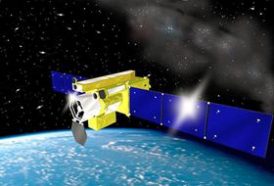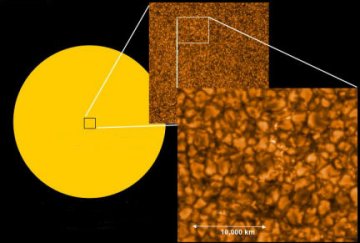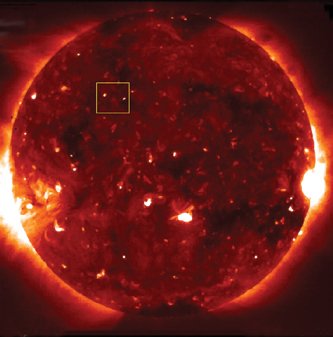Sharp Eye on the Sun
An X-ray telescope aboard the recently launched Hinode spacecraft is capturing detailed images of the sun.
Share this:
- Share via email (Opens in new window) Email
- Click to share on Facebook (Opens in new window) Facebook
- Click to share on X (Opens in new window) X
- Click to share on Pinterest (Opens in new window) Pinterest
- Click to share on Reddit (Opens in new window) Reddit
- Share to Google Classroom (Opens in new window) Google Classroom
- Click to print (Opens in new window) Print
By Emily Sohn
The sun is hotter than anything you can probably imagine, but that may not be the most striking thing about our closest star. The real surprise is that the sun’s thin outer atmosphere, or corona, is much, much hotter than the sun’s surface.
That’s like the air high above a flame being hotter than the flame itself. The temperature should fall as you move away from a heat source.
A new spacecraft called Hinode has just started collecting data that might help explain this solar oddity.
 |
|
The Earth-orbiting Hinode spacecraft, shown in this illustration, has telescopes and instruments for studying the sun. |
| JAXA |
Recently launched through a collaboration involving Japan, Great Britain, and the United States, Hinode can collect two kinds of information about the sun. With a half-meter-wide visible-light telescope, it takes pictures of the sun’s surface. It’s the largest solar telescope that has ever flown into space.
 |
|
Hinode’s visible-light telescope shows details of the sun’s turbulent surface, where great plumes of hot gas rise and fall to give the surface a speckled appearance. |
| JAXA |
Hinode also carries an X-ray telescope that detects hot gases in the sun’s corona.
Hinode’s X-ray telescope can record emissions that range between about 1 million and 4 million kelvins (273.15 kelvins equals 0°C or 32°F). This is an unusually wide temperature range for a detector, and it gives Hinode the power to sense the corona’s calm, quiet features as well as its hot, explosive ones. Until now, scientists have been unable to study the corona in such detail.
 |
|
New X-ray images of the sun reveal features known as X-ray bright points. Two examples are visible in the box. |
| JAXA |
The portrait (shown above) taken by Hinode’s X-ray telescope on Oct. 28 shows features called X-ray bright points. These features, it appears, are magnetic loops that trap hot gas.
By monitoring X-ray bright points, scientists hope to better understand how the sun’s corona becomes so hot. They should also get a clearer picture of how magnetic fields affect the corona.
Hinode, which means “sunrise” in Japanese, is still undergoing tests. In December, the spacecraft will officially begin a 3-year mission to unravel the sun’s secrets.—E. Sohn
Going Deeper:
Cowen, Ron. 2006. New eye on the sun. Science News 170(Nov. 11):309. Available at http://www.sciencenews.org/articles/20061111/fob6.asp .
Information about the Hinode (Solar-B) spacecraft and mission is available at solarb.msfc.nasa.gov (NASA) and www.jaxa.jp/press/2006/10/20061031_hinode_e.html (Japanese Aerospace Exploration Agency).
McDonagh, Sorcha. 2003. Zooming in on the wild sun. Science News for Kids (July 2). Available at http://www.sciencenewsforkids.org/articles/20030702/Note3.asp .
Sohn, Emily. 2006. Predicting solar storms. Science News for Kids (March 15). Available at http://www.sciencenewsforkids.org/articles/20060315/Note2.asp .
______. 2003. Sun flips out to flip-flop. Science News for Kids (Dec. 10). Available at http://www.sciencenewsforkids.org/articles/20031210/Note2.asp .






